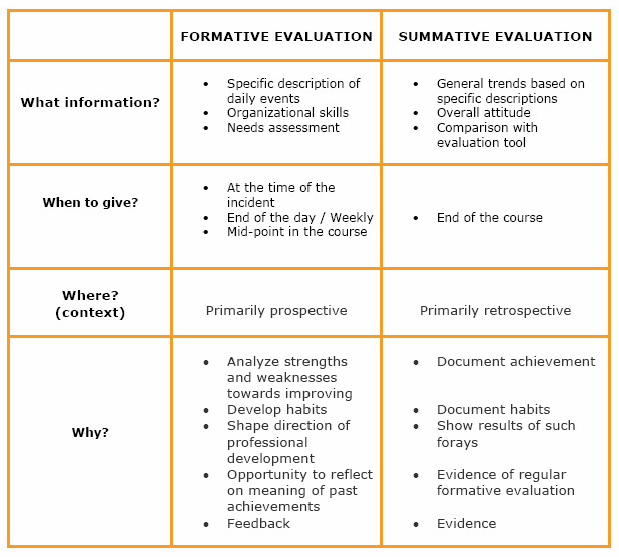Difference between revisions of "Summative Evaluation"
From Learning and training wiki
| Line 1: | Line 1: | ||
| − | {{Term|SUMMATIVE EVALUATION|Gathering of information at the conclusion of a course or a program to improve learning or to meet accountability demands. When used for improvement, impacts the next [[cohort|cohort]] of learners taking the course or program, since the course will be changed on the basis of previous cohort evaluation.<ref>[http://www.aacu.org www.aacu.org] (25 March 2008)</ref>.The conduction of a summative evaluation requires the identification of specific characteristics related to the kind of information provided, the timing and the aim - the what, where and why one can find in the [[#Formative versus Summative Evaluation|Formative versus Summative Evaluation table]]. Ideally, the two modes are complementary. Also, as noted in the table below, the process of formative evaluation may be an important component in summative evaluation.<ref>[http://www.sru.edu www.sru.edu] (5 November 2008)</ref>. See also: [[Evaluation]], [[Formative Evaluation]] | + | {{Term|SUMMATIVE EVALUATION|Is intended to provide information about the merit, worth and impact of a project.<ref>[http://www.un.org/Depts/oios/mecd/mecd_glossary/index.htm Office of Internal Oversight Services (OIOS). Monitoring, Evaluation and Consulting Division, 2006.]</ref> Summative evaluation is usually conducted at the end of a programme or project to determine if anticipated results were achieved. Summative evaluations include impact evaluations, cost-effectiveness investigations and case studies.<ref>Imas Linda G. Morra, Rist C. Ray. The Road To Results; Designing and Conducting Effective Development Evaluations pp.10. The World Bank, Washington DC, 2009.</ref> |
| + | |||
| + | |||
| + | Gathering of information at the conclusion of a course or a program to improve learning or to meet accountability demands. When used for improvement, impacts the next [[cohort|cohort]] of learners taking the course or program, since the course will be changed on the basis of previous cohort evaluation.<ref>[http://www.aacu.org www.aacu.org] (25 March 2008)</ref>.The conduction of a summative evaluation requires the identification of specific characteristics related to the kind of information provided, the timing and the aim - the what, where and why one can find in the [[#Formative versus Summative Evaluation|Formative versus Summative Evaluation table]]. Ideally, the two modes are complementary. Also, as noted in the table below, the process of formative evaluation may be an important component in summative evaluation.<ref>[http://www.sru.edu www.sru.edu] (5 November 2008)</ref>. See also: [[Evaluation]], [[Formative Evaluation]] | ||
=='''Formative versus Summative Evaluation'''== | =='''Formative versus Summative Evaluation'''== | ||
Revision as of 12:19, 20 July 2011
| Is intended to provide information about the merit, worth and impact of a project.[1] Summative evaluation is usually conducted at the end of a programme or project to determine if anticipated results were achieved. Summative evaluations include impact evaluations, cost-effectiveness investigations and case studies.[2]
Formative versus Summative Evaluation
|
| Below you have a list of selected websites where you can find additional information: |
| Link | Content |
|---|---|
| The Summative Evaluation Guide | A guide for conducting summative evaluation. |
| How to do summative training evaluation | Objectives and steps of summative evaluations. |
| Introduction to Evaluation | Different types of summative evaluation, and a few evaluation questions and methods. |
References
- ↑ Office of Internal Oversight Services (OIOS). Monitoring, Evaluation and Consulting Division, 2006.
- ↑ Imas Linda G. Morra, Rist C. Ray. The Road To Results; Designing and Conducting Effective Development Evaluations pp.10. The World Bank, Washington DC, 2009.
- ↑ www.aacu.org (25 March 2008)
- ↑ www.sru.edu (5 November 2008)
